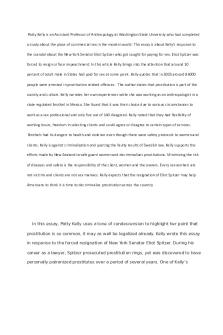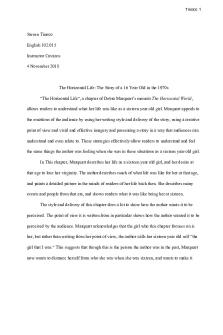Downside - Rhetorical analysis PDF

| Title | Downside - Rhetorical analysis |
|---|---|
| Author | Brian Orinda |
| Course | Education |
| Institution | Moi University |
| Pages | 6 |
| File Size | 85.8 KB |
| File Type | |
| Total Downloads | 15 |
| Total Views | 164 |
Summary
Rhetorical analysis ...
Description
Name 1 Name Professor Course Date Rhetorical Analysis of Meg Jay’s “The Downside of Living Together.” In the article titled "The Downside of Living Together," Meg Jay argues that, contrary to popular beliefs, cohabitation among couples is detrimental to their marriages' success. According to the author, cohabiting may actually increase the likelihood of divorce once such couples get married. Many young individuals in the contemporary world tend to prefer living together for a while before settling down. However, such cohabitation contributes to what the author calls the "cohabitation effect," which includes divorce and dissatisfaction with marriage life for such individuals. The author argues that general differing expectations and marriage standards cause this effect by cohabiting partners. For instance, she argues that men and women have diverse views concerning cohabitation, with men using it to test their relationships. In contrast, women see it as a stepping stone to marriage. Such differing perspectives contribute to adverse outcomes for cohabiting couples, given the lack of understanding and conflicting goals for the relationship by either gender. Jay uses various rhetorical strategies to inform and persuade young couples against cohabiting before marriage to support her arguments. The article effectively persuades and informs young couples through the use of ethos, pathos, logos, and fallacy as rhetorical devices for arguments against cohabiting before marriage. Jay employs ethical appeals to persuade and inform young couples about the dangers of cohabiting before marriage. She achieves this by using formal language, using credible sources, and explicitly stating her expertise. Throughout the article, the author uses formal language to
Name 2 provide clarity to her arguments. For instance, she writes that "One thing men and women do agree on, however, is that their standards for a live-in partner are lower than they are for a spouse" (Jay 404). Here, formal language offers the contrasting expectations of men and women when they live together before marriage. The author also uses formal language to provide definitions for various terms that may be unclear for readers. For instance, she defines consumer lock for readers as "the decreased likelihood to search for, or change to, another option once an investment in something has been made" (404). The author also uses various credible sources in her arguments, such as in providing statistics from the National Marriage Project, Department of Health and Human Services, and the Pew Research Center (404). All these research sources are referenced in the article and provide credible statistical findings for Jay's arguments. Notably, Jay establishes her credibility as a psychologist and marriage counselor by referencing her clients, such as Jennifer, and therapy sessions she has had with diverse clients (403). Ultimately, by using ethos as a rhetorical device, the author manages to gain credibility and enhance the persuasiveness of her arguments against cohabiting and enhances the informational value of the article to concerned readers. The article also effectively uses pathos to convince and inform readers about the dangers of cohabiting before settling down. For example, Jay argues that cohabiting couples tend to slide into marriage without extensive discussions and agreed-upon decisions by partners (404). This typically involves "Moving from dating to sleeping over to sleeping over a lot to cohabitation" (404). Here, Jay appeals to the reader's emotions as they can easily relate to contemporary dating lives characterized by sleep-overs and multiple dates. Additionally, the author presents diverse emotional challenges faced by cohabiting couples that drive them towards divorce. For instance, her client Jennifer sobs when narrating that she "spent more time planning my wedding than I
Name 3 spent happily married," (403). In all these instances, Jay uses pathos to effectively draw readers to the disappointment, anger, and sadness that may typically follow cohabitation. Jay effectively uses logical appeals to persuade and inform readers against living together before marriage. For instance, she argues that cohabiting individuals often get stuck in conflicted marriages that end up in separation or divorce. Jay compares this tendency by cohabiting couples to get stuck in unhealthy relationships and marriages to the credit-card system. She writes that "It's like signing up for a credit card with 0 percent interest. At the end of 12 months when the interest goes up to 23 percent you feel stuck because your balance is too high to pay off" (404). Here, the author effectively compares cohabitation to the financial challenges typically faced by individuals in every-day life. Also, Jay uses her clients to extend her logical arguments against cohabiting before marriage. For instance, Jennifer, at one point, quips that "We lived together! How did this happen?" (403). In this instance, Jennifer acknowledges that her marriage is in distress despite having cohabited for over four years before marriage (403). The author logically explains that regardless of how long individuals may cohabit, their marriages may still end up like her client Jennifer's. The article uses a rhetorical question that effectively draws the reader to Jay's primary argument and logic that cohabitation has adverse effects such as divorce for any couple. By appealing to the reader's logic, Jay manages to effectively paint a vivid picture of what cohabiting couples can expect in their future marriages based on past and real-life experiences. The author uses several fallacies in her arguments to further her arguments against cohabitation before marriage. For instance, she uses a strawman fallacy when she says that, "The greater the setup costs, the less likely we are to move to another, even better, situation, especially when faced with switching costs, or the time, money and effort it requires to make a change"
Name 4 (404). Here, the author simplifies the institution of marriage to one about investments and finances, which, she argues, makes it difficult for individuals to separate despite the marriage challenges. Essentially, her fallacious argument is intended to create a perception of dread amongst readers on the dangers of cohabitation to success in marriage. Further, Jay uses a pathetic fallacy when she writes that "nearly half of 20-somethings agreed with the statement, "You would only marry someone if he or she agreed to live together with you first, so that you could find out whether you really get along" (404). Here, the author does not provide a specific age or the actual number of participants in the mentioned research study. Instead, she uses a generalization with readers expected to agree with the known rather than the unknown aspects of the quoted research. Ultimately, fallacies are used in the article to simplify arguments to effectively convince and inform readers of the author's reservations against cohabiting before marriage. Despite the strong arguments provided in the article, various counterarguments exist against them. For instance, Jay argues that cohabiting partners must use "cohabitation as an intentional step toward, rather than a convenient test for, marriage or partnership" (405). Here, the author suggests that cohabitation must necessarily lead to marriage. However, according to the Pew Research findings in 2019, about 70 percent of Americans believe that cohabitation must not necessarily lead to marriage (Horowitz et al. n.p.). Indeed, numerous individuals tend to cohabit without committing themselves to married life. Additionally, her pathetic fallacy that individuals tend to cohabit to understand each other better before marriage is simplistic (404). Essentially, this argument is weak as the same is true for all relationships in the world, which require, among other things, commitment, cost-sharing, and understanding. Ultimately, Jay's use
Name 5 of fallacies and her insistence on marriage following cohabitation weaken her primary argument against living together before marriage. Jay's article uses ethos, pathos, logos, and fallacies as rhetorical devices to effectively persuade and inform readers of the dangers of cohabiting before getting married. These rhetorical devices are primarily intended to provide researched information, provide real-life examples, and enhance the author's credibility among the audience. In the end, the article effectively manages to offer insights on the challenges that cohabiting may cause for future marriages. These are provided as divorce, misunderstandings, and getting stuck in loveless and conflicted marriages. Ultimately, it is crucial that cohabiting couples, as argued by Jay, carefully discuss their expectations and motives in the relationship to eliminate any possible challenges to their married lives.
Name 6 Works Cited Horowitz, Juliana M et al. Marriage and Cohabitation in the U.S. Pew Research Center, 6 Nov 2019, https://www.pewsocialtrends.org/2019/11/06/marriage-and-cohabitation-in-the-u-s/ Seyler, Dorothy U, and Allen Brizee. Read, Reason, Write: An Argument Text and Reader. McGraw-Hill Education, 2019....
Similar Free PDFs

Downside - Rhetorical analysis
- 6 Pages

Rhetorical Analysis
- 5 Pages

Rhetorical analysis
- 2 Pages

Puppy Rhetorical Analysis
- 4 Pages

Rhetorical analysis -1
- 4 Pages

Bowling Dana Rhetorical Analysis
- 4 Pages

Rhetorical Analysis Essay
- 5 Pages

Textual Rhetorical Analysis
- 3 Pages

Rhetorical Analysis Final
- 5 Pages

Rhetorical Analysis Prompt
- 2 Pages

Final Rhetorical Analysis Essay
- 2 Pages

Rhetorical analysis pt1
- 2 Pages

Rhetorical Analysis - enc2135
- 6 Pages
Popular Institutions
- Tinajero National High School - Annex
- Politeknik Caltex Riau
- Yokohama City University
- SGT University
- University of Al-Qadisiyah
- Divine Word College of Vigan
- Techniek College Rotterdam
- Universidade de Santiago
- Universiti Teknologi MARA Cawangan Johor Kampus Pasir Gudang
- Poltekkes Kemenkes Yogyakarta
- Baguio City National High School
- Colegio san marcos
- preparatoria uno
- Centro de Bachillerato Tecnológico Industrial y de Servicios No. 107
- Dalian Maritime University
- Quang Trung Secondary School
- Colegio Tecnológico en Informática
- Corporación Regional de Educación Superior
- Grupo CEDVA
- Dar Al Uloom University
- Centro de Estudios Preuniversitarios de la Universidad Nacional de Ingeniería
- 上智大学
- Aakash International School, Nuna Majara
- San Felipe Neri Catholic School
- Kang Chiao International School - New Taipei City
- Misamis Occidental National High School
- Institución Educativa Escuela Normal Juan Ladrilleros
- Kolehiyo ng Pantukan
- Batanes State College
- Instituto Continental
- Sekolah Menengah Kejuruan Kesehatan Kaltara (Tarakan)
- Colegio de La Inmaculada Concepcion - Cebu


